Künker: The Top Ten of the Ancient Coins Sales
This year, Künker’s Fall Auction Sales were divided into two parts: from 18 to 21 October 2022, nothing but ancient issues were on offer during the second part of the auction sales. With about 2,000 lots, including numerous high-quality pieces, auction 376 and 377 provided collectors with one of the most extensive offers Künker ever presented to its customers. The total estimate was about 4 million euros, the total result amounted to impressive 7 million euros.
Auction 377 with another part of the Salton Collection, this time mainly Roman coins, was followed by an eLive Premium Auction. At the end of both sales, the total result for this part of the collection amounted to 1.4 million euros. The estimate had not even been half a million euros, which means that the price almost tripled. This is particularly pleasing as all proceeds from the sale of the Salton Collection will go to charities. The total result of all eight auction catalogs – thus of auction 372-377 with coins and medals from antiquity, modern times and phaleristic objects – was 17 million euros.
The Top Ten of Künker’s Sales of Ancient Coins
In this review, we present the top ten of both sales of ancient coins. The rule is: if both coins realized the same result, the coin with the lower estimate will get the higher rank. If both hammer prize and estimate are the same, there is a tie and the next-lower place will be skipped.
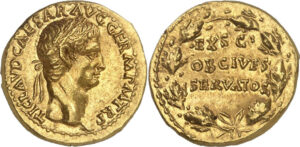
9th Place
Therefore, our top ten list starts with two coins in 9th place. The two lots had an estimate of 30,000 euros. Both fetched 55,000 euros. The first one is an aureus by the Roman Emperor Claudius. It depicts an unusually realistic portrait, is sharply minted and of the highly popular “FDC” quality. On the reverse is a oak wreath, the Roman Corona Civica, which – as the Latin inscription on the reverse states – was awarded to him because he [Claudius] had saved the citizens.
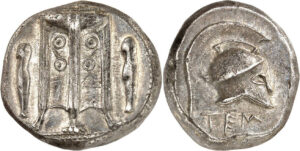
9th Place
The second one of the two coins is from Temesa, a Greek settlement in the Savuto valley, a river in Southern Italy. The exact location of Temesa isn’t known to this day. If we are to believe Pausanias, a daimon named Polites haunted this place. He had once been human and was a crew member of Odysseus. The inhabitants of Temesa stoned the soldier because he raped a young woman. Odysseus therefore refused to bury him, which is why the spirit of Polites found no rest and plagued the city. Following the advice of the Oracle of Delphi, the inhabitants of Temesa put an end to the haunting by building a temple to the daimon Polites and worshipping him. The image on the early stater might recall this development. After all, the tripod was the sign of Apollo and the seat of Pythia. The helmet and the greaves can well refer to a Greek fighter at Troy.
By the way, Pausanias tells this story in connection with the victory statue of Euthymos, parts of which are still preserved in Olympia today. He was proud to have won the Olympic Games three times as a boxing champion. Pausanias recounts that the athlete challenged the spirit of Polites to a fight and he won, whereupon Polites finally disappeared.
The stater of Temesa that Künker was able to offer at auction was not only fully centered but also of magnificent quality – it is probably the best known specimen, a good reason why the coin was sold for almost twice its estimate.
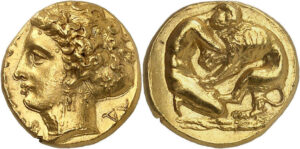
8th Place
In the 5th century BC, the best engravers of their time worked for the city of Syracuse. One of them, Kimon, designed the prototype of the 100-litrae gold piece that was offered by Künker. Its obverse features the well-known head of Arethusa, the reverse Heracles wrestling with the Nemean lion because normal weapons could not penetrate the fur of the wild animal. Although this coin is not made from Kimon’s dies, the artist who made them created a wonderful depiction. The provenance of the specimen can be traced back to 1965. It is of extremely fine quality. The coin was estimated at 50,000 euros and realized a hammer price of 65,000 euros.
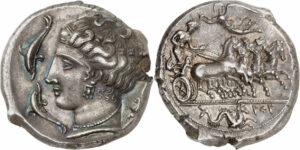
7th Place
65,000 euros – more than twice the estimate of 30,000 – was fetched by this wonderful tetradrachm from Panormos, today’s Palermo. It is an exceptionally well-preserved Carthaginian imitation of the popular tetradrachms of Syracuse, and – for once – the Carthaginian imitation is by no means inferior to the Greek original. On the contrary, the chariot on the reverse is as vividly designed as only the greatest Syracusan engravers managed to do. Arethusa’s head may be a little more stylized but its proportions are magnificent. The coin is a first-class work of art.
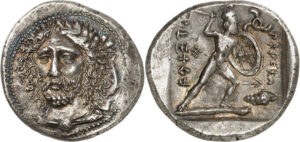
6th Place
This holds also true regarding the stater of the Lycian satrap Perikle, who controlled Lycia between 380 and 362. It is one of the early portraits, which were created on the border between the Greek population and the Persian Empire. This coin is remarkable because its incredible condition allows us to acknowledge the great artistry of the master who created the die. The artist apparently knew Kimon’s famous frontal representation of the spring nymph Arethusa; for he imitated the flowing hair of the deity and even integrated one of the four dolphins into his depiction.
The portrayed satrap Perikle is not only mentioned by ancient historians; archaeology associates his name with a monumental tomb excavated near the city of Limyra / Antalya Province. In other words: the new owner of this coin purchased a wonderful work of art that also provides insight into ancient history. Therefore, he was prepared to pay three and a half times its estimate: the lot was estimated at 20,000 euros and achieved a hammer price of 70,000 euros.
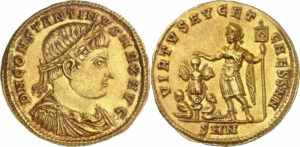
5th Place
Extremely rare – that’s how one must describe the medallion of 1 1/2 solidi who jumped from an estimate of 50,000 euros to a total result of 75,000 euros. The piece, minted in 324 in Nicomedia, is extremely rare and not even listed in the RIC. On the reverse, it depicts the victorious Emperor Constantine I with a standard, a trophy in front of it and two prisoners crouching below.
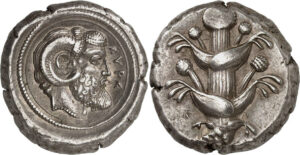
4th Place
An almost enchanting archaic image of Zeus Ammon is presented by a tetradrachm from the city of Cyrene, minted between 480 and 435. Cyrene is located in today’s Libya. It was the oldest and most important Greek polis in the region, which owes its name Cyrenaica to it. Its prosperity was based on its fertility. North Africa was a granary of the Roman Empire and therefore remained prosperous even after the famous silphion became extinct, which we can see on the coin’s obverse. The plant probably owes its current fame to the fact that it had already ceased to exist in Roman times.
The coin’s reverse shows an impressive head of Zeus, who had a monumental temple in Cyrene. The building was larger than the Parthenon of Athens or the temple of Zeus in Olympia. For the inhabitants of Cyrene, their Zeus had adopted some features of the Egyptian god Amun. After all, one of the most important sanctuaries of Amun was located in the Siwa Oasis, which was only about a five days’ journey from Cyrene. We mainly know it because it was there that Alexander the Great received the prophecy that he was a child of this god, which – incidentally – is why the tetradrachms of Lysimachus featuring the image of Alexander are very similar to Cyrene’s coins. This coin with its fine style and its wonderful toning was estimated at 30,000 euros and the hammer did not fall until 75,000 euros.
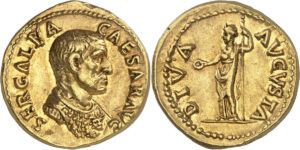
3rd Place
The third most expensive coin of the auction, an aureus of Galba with a highly realistic portrait and an estimate of 60,000 euros, was sold at 80,000 euros. The emperor wears an aegis, the protective armor we usually associate with the goddess Athena. The question of what this aegis was has been disputed since ancient times. Homer claimed that it was a shield made by Hephaestus, who gave it to Zeus. Athena wore the aegis as a kind of cloak, with the head of Gorgon Medusa embedded in it. Perseus is believed to have brought it to her for this purpose. Homer recounts in the Iliad that the Achaeans froze in terror when they saw the aegis. And, in fact, that is the message Galba wants to spread with this aureus: his enemies should freeze in terror in the face of his power.
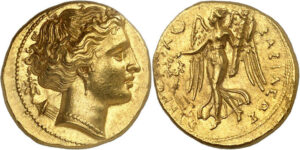
2nd Place
At first sight, this wonderful coin from the city of Syracuse seems to be differ from the rest. On the obverse, it features the head of Artemis, whose style is very reminiscent of the Arethusa portrait and can only be identified as Artemis thanks to the tiny quiver and the bee. On the reverse, Nike, the goddess of victory, strides along to crown the name of Pyrrhos, who is responsible for this coin. On other pieces, you can see that Nike wears an oak wreath as a reference to the sanctuary of Zeus located in Epirotic Dodona. After all, Pyrrhos had originally been the ruler of a small kingdom in Epirus before he set out to attack Rome. During the battle, there was a short-lived collaboration with Syracuse, during which this coin was created.
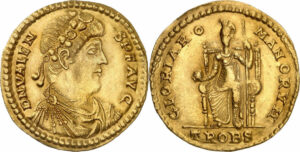
1st Place
With a hammer price of 340,000 euros, a wonderful medallion of Emperor Valens from the period between 375 and 378 became the top lot of the auction. The estimate had already amounted to 200,000 euros. No surprise – after all, heavy gold medallions are considered the supreme discipline in collecting ancient coins. With 20.39 g, the coin equaled the weight of 4 1/2 solidi and was an imperial gift for a high-ranking officer or administrative official.
Only three specimens of this coin type are known of. The one offered at Künker was by far the one of the best quality and also the only one on the market. The other two already belong to museums. But what probably completely convinced the buyer was the piece’s exceptional provenance. The coin is from the Salton Collection. It was purchased in 1947 from the Italian company Ratto for 448,500 francs.
Although only high-priced specimens were featured in this review: there were many coins in the auction sale that could be bought for little money. Take a look at the auction results and see for yourself. After all, coin collecting is a rewarding hobby for anyone!
All results can be found in the online catalog.
For more information visit the Künker website.





